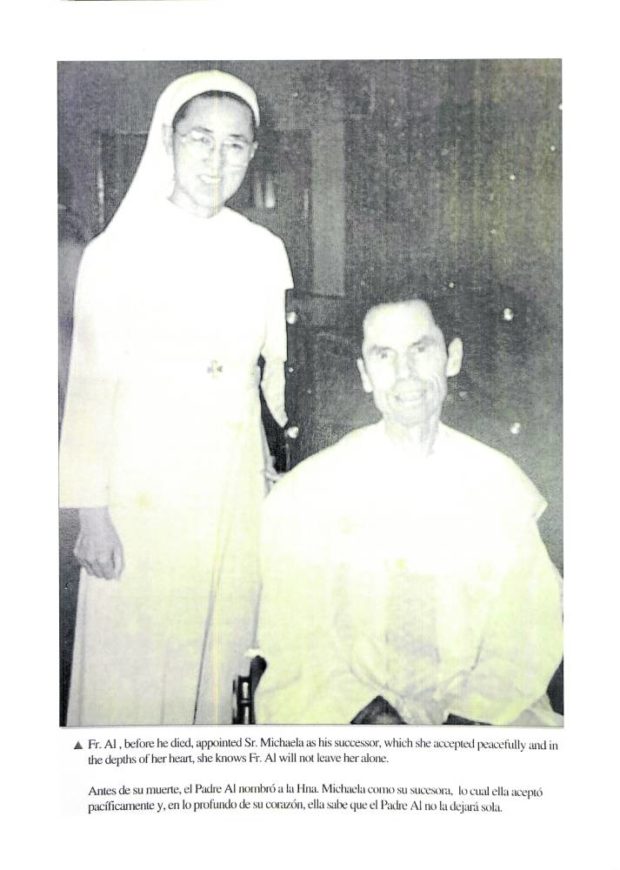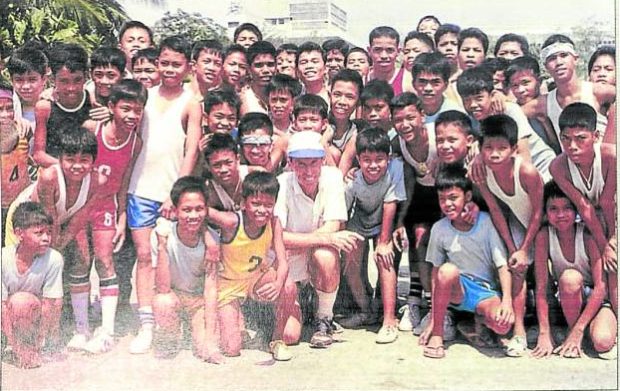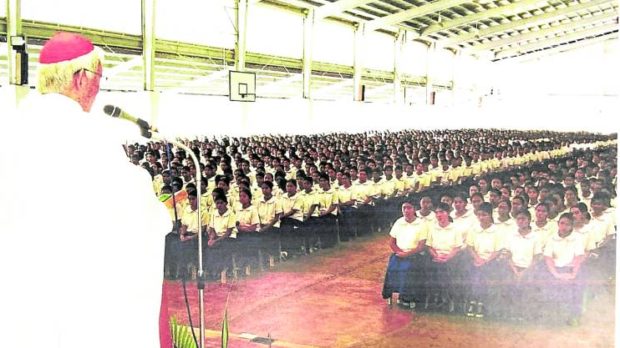Healing poverty: Fr. Aloysius Schwartz

NEVER ALONE | Before he died, Father Aloysius Schwartz appointed Sister Michaela Kim as his successor. She accepted the responsibility knowing in the depths of her heart that Father Al will not leave her alone. (CONTRIBUTED PHOTO)
Poverty is a disease that some deem incurable. Many are born into it and die in the same cruel and corrupt system. Often there are no choices for the poor; they are thrust into the wrong spaces filled with violence and illegal drugs.
Poverty is a slow and silent killer: a life ends, not with the eruption of an aneurysm, but with an empty stomach and a parched throat.
Malnourished children sell sampaguita strands and sticks of cigarettes on the streets. Slums flourish beside mountains of trash and polluted creeks. Countless lives are lost each year to the absence of resources to meet even the most basic human needs.
Some may think there is no cure, but a very special few dedicate their entire lives to blazing a trail out of poverty, a pathway toward a healthy and happy life.
Among them was the Venerable Aloysius Schwartz, affectionately known as Father Al.
Feeling their pain
Imagine this: an American priest leaves a life of comfort to provide homes and quality education to orphaned South Korean children. His experience in South Korea inspires him to open schools worldwide, and to this day, many impoverished children and their families are being lifted out of poverty through his sacrifice, hard work and faith.
Born to a Catholic family in Washington on Sept. 18, 1930, the young Aloysius knew early on that he would dedicate his life to serving the poor. He came of age during World War II and the Korean War. Growing up, he idolized the “Boy Commandos,” a comic-book squad of orphaned children who spent their lives saving others.
After being ordained priest in the summer of 1957, he was assigned to Busan and moved there in the winter to manage an orphanage. He lived in an unheated wooden shack, determined to experience the struggle of the poor and the orphaned. By feeling their pain, he was able to understand what they truly needed to survive.

ONE OF THE BOYS | Father Al after jogging with a group of boys at Rizal Park, at a time before he was diagnosed with ALS (amyotrophic lateral sclerosis).
Father Al set up the nonprofit Korean Relief to raise funds for the welfare projects he had in mind. He took photographs of the sick and hungry orphans and mailed them in letters to the United States, seeking donors to support the children he now considered his own.
Villages for Children
He soon realized that he needed more help in his mission. It took a village to raise a child, after all, and these orphanages were going to raise thousands of children. So he founded the Sisters of Mary, a religious congregation that would help him achieve his goals.
With generous donations from friends and benefactors, Father Al and the Sisters of Mary built the first Villages for Children — also called Girlstowns and Boystowns — where those orphaned by the war were fed, clothed, and educated, all for free, and where he could plant the seeds of the bright future that he envisioned for them.
Father Al and the Sisters of Mary also built hospitals and tuberculosis sanatoriums and personally cared for the patients — changing bedsheets and bedpans, feeding the invalid and the malnourished, and later putting up hospices for the homeless and the handicapped.
From South Korea, Father Al launched similar programs elsewhere, starting with the Philippines in 1985. Today, the four Villages for Children in the Philippines are caring for more than 11,000 kids.
After graduation, they find jobs where they apply the vocational skills they learned. A lucky few find scholarships to go to university.
But just four years after Father Al built the first Girlstown and Boystown in Manila, he was diagnosed with the incurable and painful neurodegenerative disease ALS (amyotrophic lateral sclerosis).
Despite his increasing disability, he was still able to open the first Village for Children in Mexico in 1990.
Servant of God
Father Al died of ALS on March 16, 1992, at Girlstown in Manila and was buried at Boystown in Silang, Cavite. But until the end he worked tirelessly, enduring the pain of his disease to ensure the stability of his mission even after his passing. When ALS took away his ability to write, he spoke in videos urging donors to continue financially supporting and caring for the children.
In 2015, Pope Francis declared Father Al “Venerable,” citing his life of heroic virtue.
It is the second of four steps toward canonization, which is not an easy process.
A committee is assigned to study the life of a candidate for sainthood, to see if one lived a holy, kind and devout life. If proven so, the candidate is recognized as a “Servant of God.”
Scrutiny
Father Al’s case for sainthood was opened in 2003, and he was declared a Servant of God in May 2004.
The committee then scrutinizes the candidate’s life to see if one possessed four cardinal virtues and three theological virtues. If one did, only then is one declared Venerable.
The steps toward beatification and canonization each require a posthumous miracle.

SPECIAL GUEST Cardinal Gaudencio Rosales speaks during a July 2007 event at Girlstown Cavite, one of Father Al’s enduring legacies in the country.
A subclause states that if the candidate was martyred—killed or persecuted in the name of their faith—they may automatically be beatified. While Father Al was not targeted by ALS solely because of his religion, in many ways he gave up his life for his faith, serving, through his pain, as the bridge between the broken hearts of poor children and God’s loving warmth.
Until the end, he heard confessions and celebrated Mass in his wheelchair. He died serving his faith, and his physical deterioration was a metaphorical martyrdom.
In 2017, Pope Francis introduced a new path toward sainthood that recognizes those who “have offered their life voluntarily and freely for others and have persevered in this to death.”
Main criteria
The Vatican’s official news service lists four main criteria for this pathway:
• “The free and voluntary offering of life and the heroic acceptance out of charity of certain death in a short term.” Additionally, there must be “a link between the offering of life and the premature death.”
• “The practice of the Christian virtues, at least to an ordinary degree, before the offering of [one’s] life, and then until death.”
• “The existence of the fame of sanctity and of signs [of holiness], at least after death.”
• “The need for a miracle for beatification, that happens after the death of the Servant of God and through his/her intercession.”
There is no doubt that Father Al lived for others. Even after he was diagnosed with a terminal illness, ensuring his “certain death,” he continued to offer his life and guiding light to those around him.
He dedicated his life to the poor, but died due to a sickness he did not choose; he merely accepted it as part of God’s plan.
Father Al exuded Christian virtues in every aspect of his life, which thousands of people around the world can attest to. His selfless goal of providing a better life for poor children—doing so on a global scale—is perhaps one of the holiest things a person can do.
To be beatified and then canonized, Father Al needs recorded posthumous miracles. Those miracles can well be the lives of all the poor children who were helped by his programs. He might not have healed them of incurable tumors or ailments, but he rescued them from the vicious cycle of poverty and, as in most healings, gave them a new life.
Poorest of the poor
To fully understand Father Al’s life work, perhaps it is necessary to first paint a picture of the children’s lives before they attended Girlstown or Boystown.
They are among the poorest of the poor. With food hardly ever on the table, they have to stop their schooling to help earn money for the family’s upkeep. Some children are orphaned or abandoned, left to fend for themselves on the streets, exposed to illness, infection and criminal ways.
Without proper education, they are unable to gain suitable employment as they grow older, and find themselves in the same predicament as their forebears. Through Father Al’s intervention, poor children are shown a way out of this cruel fate.
Upon arrival at Girlstown or Boystown, some children are shocked to learn that they each have their own bed (they never had such a benefit before). They are taught the basics in personal hygiene (they grew up in communities with no running water).They are provided food, shelter, clothing, medical care and an education, setting them up for a better future.
Until today, Father Al’s schools teach a complete range of subjects to prepare students for productive work after graduation.
Intensive vocational training, also offered for free, allows students to learn skills they can apply in local industries, such as carpentry, cooking, automotive mechanics, dress- and jewelry-making, computer drafting, accounting, and graphic design.
They are given space to develop mental and spiritual wellness. Emotional counseling allows them to reflect on the hard life they have earlier endured, and teaches them to grow, and not spiral down, from their experiences.
After graduation, students often find on-the-job training in local businesses that are partners of the Sisters of Mary, or proceed to higher education through the generosity of a sponsor. Graduates have gone on to become doctors, teachers, accountants, lawyers, government officials, even professional athletes.
Giving back
Many of the alumni, once they make their own living, give back: they fund the education of younger siblings or extended-family members. They invest their blessings into their barangays, in essence changing the lives of entire communities.
Through Father Al’s sacrifice, they not only break out of poverty but also help lift up others stuck in the cycle.
Sainthood for Father Al is not for his popularity (he himself always shunned the limelight). It is, like many of his goals, to ensure that the children under his care will receive the tools they need to survive in the world beyond the slums.
The seven Girlstowns and Boystowns around the world have produced about 157,000 graduates so far, but their operations are solely dependent on donations. With a global recognition of sainthood for Father Al, his reach will expand farther and will provide a secure future for his schools.
Potential donors worldwide will know of his work in helping impoverished kids reach heights they never dreamed of.
Death anniversary
Today is Father Al’s 30th death anniversary, and many of those who knew him fear that he and his life work may be forgotten, and that without constant donors, his charity organizations will falter and innocent lives will again be felled by poverty.
On his deathbed, Father Al urged his compatriots: “Please take care of my children.” Till the very end he thought only of others. And even after his death, the work in his memory is still all for the children.
It is imperative that his dedication to serving the poor be cemented in the history of the world, so that his love can reach generations to come.
(Email the author at jordan prietovaldes@gmail.com)
RELATED STORY